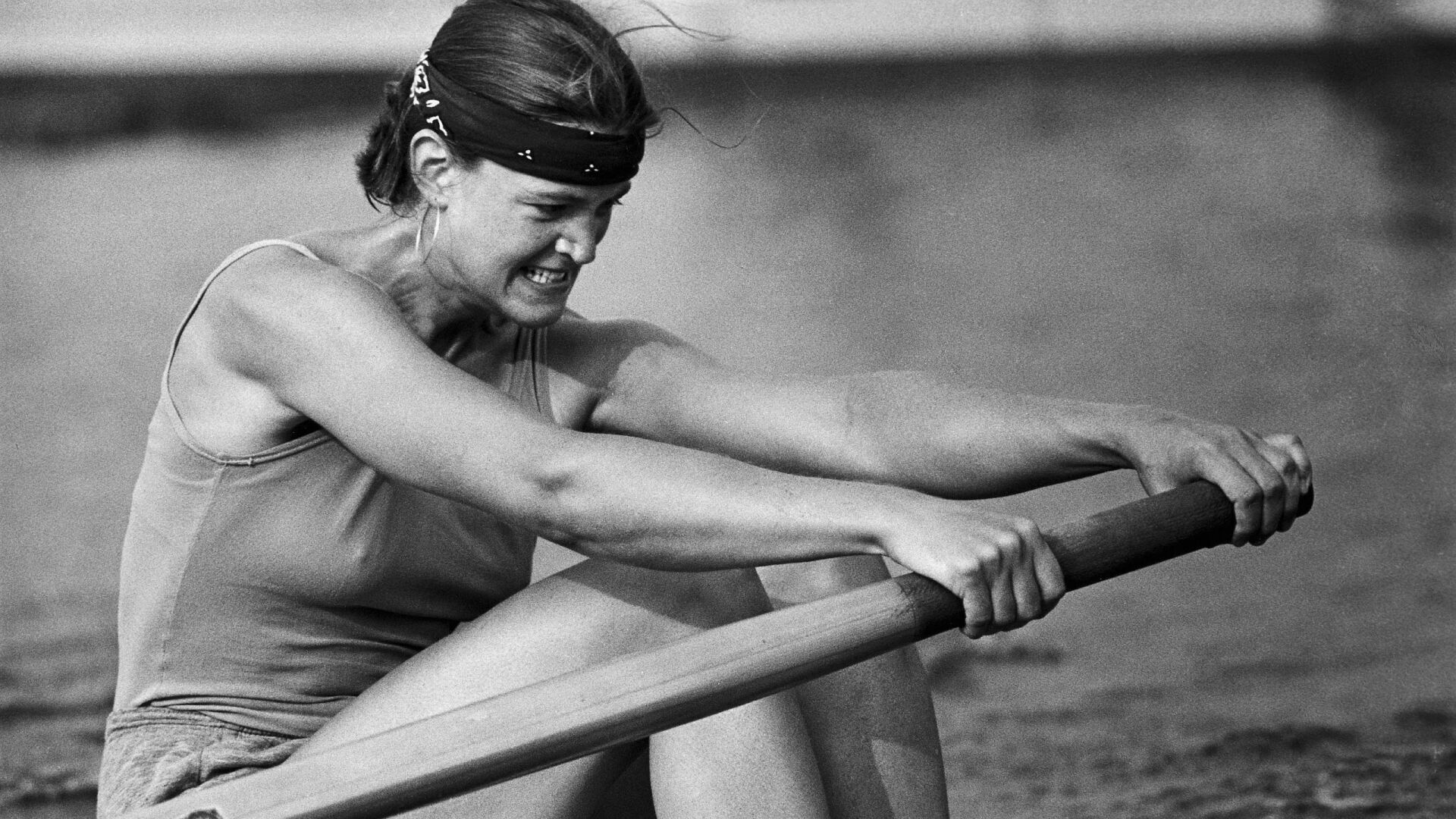
Aug 24, 2025
Team USA
The Red Rose Crew: 50 Years of Breaking Barriers in Women’s Rowing
On August 24, 1975, in Nottingham, England, the second U.S. women’s eight ever to compete at the World Rowing Championships stunned the rowing world. They battled the powerhouse East Germans down the course and claimed silver, the first international medal for U.S. women’s rowing.
This moment almost never happened. Gail Pierson, the boat’s seven-seat, had spent years lobbying for more support for women rowers. She petitioned the U.S. Olympic Committee to establish a separate board and funding for women, which led to the formation of the Women’s Olympic Rowing Committee (WORC). But there was resistance from Vesper Boat Club, which had fielded the previous year’s women’s eight, who sued to stop the centralized training camp, arguing that a crew developed over time would be stronger than one assembled quickly. The decision came down to the National Championships. If Vesper won, there would be no camp. Stroking the University of Wisconsin eight, Carie Graves led her crew to victory at a blistering 39 strokes per minute, keeping the camp alive.
Team Selection
Harvard’s Harry Parker, having been passed over as the men’s national team coach, was tapped to lead the women. With Parker busy coaching at Henley, Steve Gladstone ran the first few weeks of the camp in Boston, cutting 32 hopefuls down to 18. The personalities were as varied as their sizes. At 34, Pierson was the veteran sculler turned sweep rower. Graves, 6’1”, dwarfed Yale’s Chris Ernst at 5’4”. 16-year-old Lynn Silliman cried after making the first cut, homesick, but an argument with Parker over steering sealed her spot in the coxswain seat.
They were, in many ways, pioneers breaking barriers. Yale’s Anne Warner once nearly got expelled for challenging a gym teacher who claimed girls could only dribble three times before passing a ball; the exertion would be too much otherwise. Ernst and Warner endured jeers from male athletes at the Yale weight room. Pierson faced ridicule in the NYTimes about the appearance of female rowers and fired back: “It’s all right to be strong. It’s all right to compete.” The World Championships for the women’s eight would be decided over 1,000 meters since it was believed that 2,000 meters was too physically challenging for women.
If there was any group of women who could disprove that theory, it was this one. Gladstone ran the athletes through numerous 1,000-meter pieces; shocked he was even able to do that many with the crew, his men's team would have revolted. The women were tested in fours throughout the summer, working to whittle down the number to the final eight athletes. The crew was finally selected with Carie Graves, Gail Pierson, Yale's Anne Warner, Cal State Long Beach's Claudia Schneider, Harvard’s Wiki Royden, Williams’ Nancy Storrs, Princeton’s Carol Brown, Chris Ernst, and coxswain Lynn Silliman.
1975 World Rowing Championships
The World Championships were a showdown with the sport’s giants. East Germany and the Soviet Union dominated women’s rowing. In their heat against Russia, the Americans shot off the line too high, a classic Graves move. With Silliman’s cox box dead, they managed to hang with the Russians, finishing second. Relieved to get another race underneath them, they found their rhythm, winning the repechage comfortably.
The day of the final, the wind was whipping through the course, causing a delay. When the race was called, the crew nearly missed the start, forcing Silliman to cut in front of her opponents to ensure they did not start the race while they were getting into position. They were handed a false start. The start was called, and the U.S. bolted out of the stake boats. They were neck and neck with the East Germans, having left the field behind. The East Germans took gold, just 1.6 seconds ahead of the Americans, who shocked the rowing world with their silver medal performance.
A journalist for Sports Illustrated was in attendance to cover the men’s eight, who finished a disappointing fifth place. The women’s eights performance caught his attention, and he dubbed them the Red Rose Crew, due to the color of their uniforms and the red roses that one of the sculling coaches had tied to their shoes before their race. The women had proven that not only could the U.S. women compete, they could succeed.
'76 Olympics & Trailblazing Protests
Many of them would go on to race in the first-ever women’s rowing events at the Olympic Games in 1976. Lynn Silliman, Carol Brown, Anne Warner, and Carie Graves would win bronze in the women’s eight with Olympic Hall of Famer Anita DeFrantz. The eight was coached once again by Harry Parker. Nancy Storrs would race in the four, while Claudia Schneider competed in the quadruple sculls.
Chris Ernst and Anne Warner would return to Yale after finishing second in the world to a boathouse where the women’s team would not be able to shower or change. On March 3, 1976, Warner, Ernst, and their fellow teammates walked into the Yale Director of Athletics' office and stripped naked in protest against their inadequate treatment and facilities. This protest would not only push Yale to provide facilities for its women’s rowing team, but it would also serve as a catalyst for better funding across the country for women’s sports.
Stanford's Lynn Silliman summed it up: “The sum was greater than the parts. Everyone gave 125% every single day. You can’t replicate what we had.”
She’s right—there will never be another crew like the Red Rose Crew. They didn’t just race; they transformed the sport. They laid the foundation for the U.S. women’s national team and shattered barriers for every female athlete who came after them.
Honors & Lasting Legacy
Nancy Storrs went on to become a Hall of Fame coach in Canada. The women’s eight trophy at the Head of the Charles is named for Gail Pierson, the first woman ever to race in that regatta in 1969. Carie Graves captured Olympic gold in 1984 and became the first woman to coach in the Ivy League at Harvard-Radcliffe. She was twice named Female Athlete of the Year by the U.S. Olympic Committee (1981 and 1984), and today the USRowing Female Athlete of the Year award bears her name.
The story of this trailblazing crew was chronicled by Daniel J. Boyne in The Red Rose Crew: A True Story of Women, Winning, and the Water. Chris Ernst’s advocacy would later be spotlighted in Olympic rower Mary Mazzio’s documentary A Hero for Daisy. The Daisy referenced is Daisy Mazzio-Manson, a Yale graduate and 2024 Olympic rower.
Whether through their performances on the water, their fight for equity, or their leadership as coaches, the Red Rose Crew’s impact is woven into the story of women’s rowing and women’s sports in America.
In Memory
Harry Parker, who passed away in 2011 after an extraordinary 50-year coaching career, left an unmatched record at Harvard and an enduring mark on collegiate rowing. Nancy Storrs and Carie Graves, who have also since passed, carried that same spirit of excellence. Through their strength, vision, and leadership, they helped shape the landscape of women’s rowing and inspired countless athletes for generations to come.
Gallery
See the 1975 World Championships and Red Rose Crew in pictures, with this gallery courtesy of WomensRowingArchives.org























